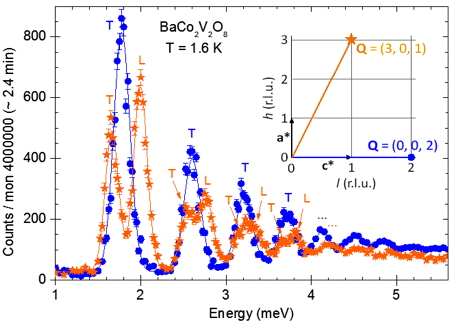In a classical antiferromagnet, the magnetic excitations, so called spin waves, correspond to a precession of the magnetic moments around their equilibrium position. As a result, a well-defined dispersion curve of transverse excitations is observed. Interestingly, the nature of the spin excitations is completely different in isotropic spin chains, where the exchange interaction is strong in one direction of space and negligible in the two other ones: The spin excitation spectrum consists of a continuum of transverse spinons, created or destroyed in pairs, similarly to domain walls in an Ising antiferromagnet. In presence of sizable inter-chain interaction, a Néel antiferromagnetic ordering can occur in such a system, and an appealing issue is to study how this ordering affects the spin dynamics. In this context, we have explored the magnetic excitations emerging from the Néel phase of the chain compound BaCo2V2O8, showing a moderate Ising anisotropy along with sizable interchain interactions. An inelastic neutron scattering experiment has been conducted in the Néel phase of a BaCo
2V
2O
8 single crystal on the three axis spectrometer IN12 at Institut Laue Langevin
[Reference]. Discrete excitations were found, instead of a continuum, composed of two interlaced series of long-lived modes polarized perpendicular (transverse) and parallel (longitudinal) to the direction of the static antiferromagnetic ordered magnetic moments (Figure). This discretization of the excitations, referred to as Zeeman ladders, is attributed to a confinement of spinons in an attractive linear potential, due to the sizable interchain interaction. The observation, for the first time, of such well-defined longitudinal excitations is ascribed to the presence of a moderate Ising anisotropy, in addition to the sizable interchain interaction. We now plan to study the evolution of the excitation spectrum of BaCo
2V
2O
8 in an applied magnetic field, where a new type of magnetic ordering is induced.
This work, in the framework of low dimensional quantum magnetism, was done in collaboration with CEA/LLB, Institut Néel, ILL, and LNCMI-G.

Q-constant energy scans (solid symbols), at two Bragg positions shown in the inset, fitted by a series of Gaussian functions (solid lines). This figure emphasizes one series of transverse modes when the scattering vector Q is parallel to the direction of the ordered antiferromagnetic moments (c-axis) and two series of interlaced sharp transverse (T) and longitudinal (L) modes when Q is nearly perpendicular to the c-axis.